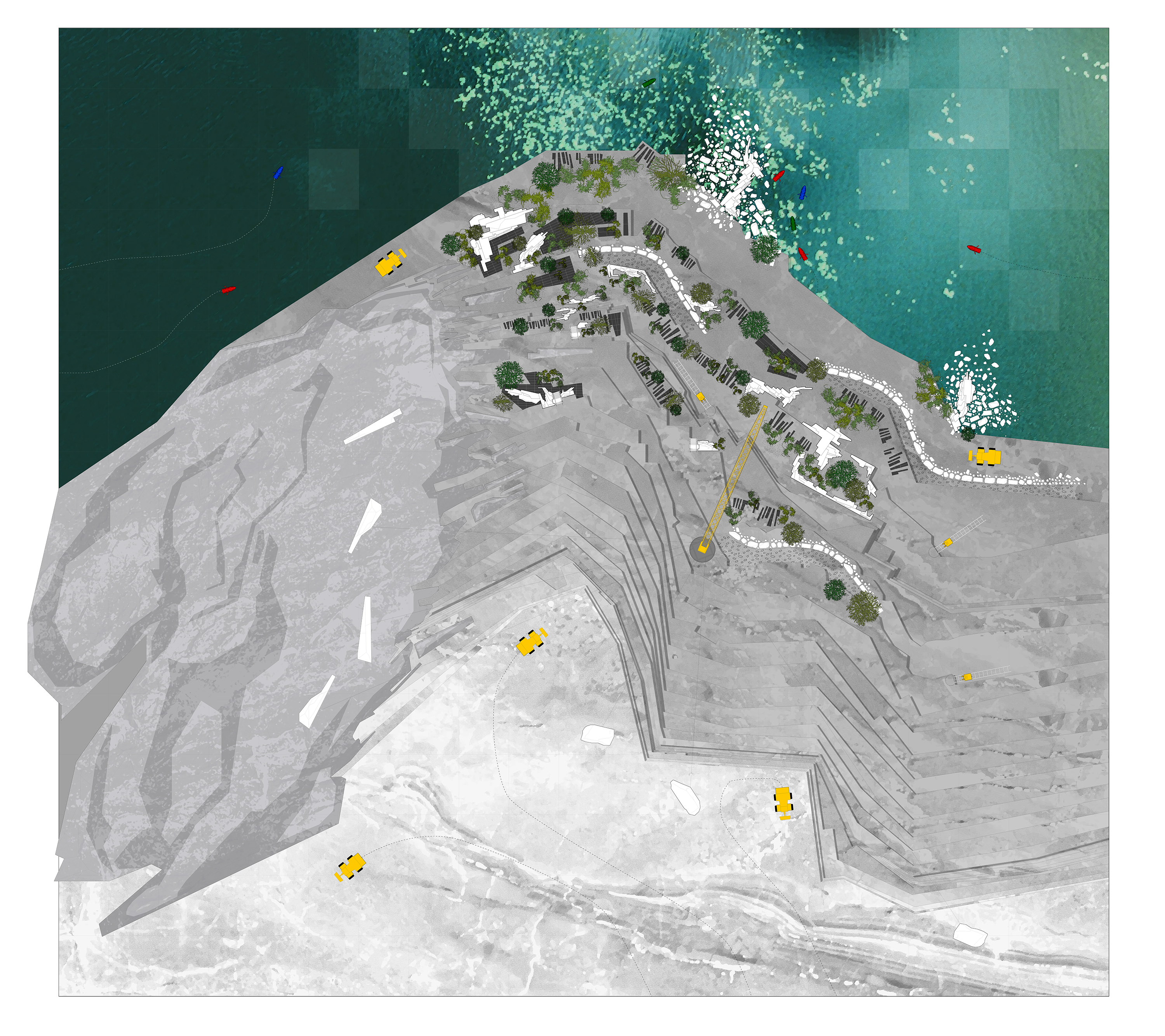︎ Hypogeal Succession
Machine Misuse and Construction in Quarry Architecture
Cornell University Fall 2023










Graduate Thesis
Advisors: Sasa Zivkovic and Christopher Battaglia
Thesis Helpers: Christopher Rouhi and Frank LaPuma
Access full thesis book here
In a post-extractive future, architects are tasked with integrating waste streams into construction practices. Hypogeal Succession posits that contemporary quarrying policies can be reconfigured to promote ecological remediation from the onset of extraction. In-situ fabrication and machine misuse will allow for the emergence and maintenance of an early succession habitat. The quarry waste rock will become occupiable masonry structures integrated in this ecological niche. The decommission of the quarry will reveal a productive landscape, allowing for economic and ecological prosperity for the region.
Historically, people have always been geological agents, extracting raw materials from the earth in order to produce tools and promote the growth of agricultural products, all of which was expedited by the industrial revolution. Continued global demand for raw materials has promoted the growth of the quarrying and mining industries. Barre, Vermont has been a hotspot for granite quarrying due to the presence of a granitic pluton close to the surface of the earth. The E.L. Smith quarry has been active since the early nineteenth century and will likely continue to be active for hundreds of years to come.
Machine misuse implies that the wheel loaders, saws, drills, and cranes already on site can be used in a different way. By adjusting the parameters of how these machines operate, the end product can be that of additive tectonics. This can create economic continuity for the town of Barre, seeing as the quarry workers can continue to operate the equipment. The goal simply chang-es: allow the quarrying process to continue, but allow the last layer of each terrace to have horizon-tal surfaces with stacked structures made out of waste rock. This will produce an early successional habitat for people, plants, and animals to prosper within.
In-situ fabrication allows for the con-struction of structures from highly custom offcuts as the material library. While it is impossible to predict what each piece will look like, it is helpful to establish some typologies as to how stones can interlock with each other. A variety of joint systems can be tested and applied to onsite rock, allowing for the construction of occupiable interventions that promote inhabitation of all kinds.
Advisors: Sasa Zivkovic and Christopher Battaglia
Thesis Helpers: Christopher Rouhi and Frank LaPuma
Access full thesis book here
In a post-extractive future, architects are tasked with integrating waste streams into construction practices. Hypogeal Succession posits that contemporary quarrying policies can be reconfigured to promote ecological remediation from the onset of extraction. In-situ fabrication and machine misuse will allow for the emergence and maintenance of an early succession habitat. The quarry waste rock will become occupiable masonry structures integrated in this ecological niche. The decommission of the quarry will reveal a productive landscape, allowing for economic and ecological prosperity for the region.
Historically, people have always been geological agents, extracting raw materials from the earth in order to produce tools and promote the growth of agricultural products, all of which was expedited by the industrial revolution. Continued global demand for raw materials has promoted the growth of the quarrying and mining industries. Barre, Vermont has been a hotspot for granite quarrying due to the presence of a granitic pluton close to the surface of the earth. The E.L. Smith quarry has been active since the early nineteenth century and will likely continue to be active for hundreds of years to come.
Machine misuse implies that the wheel loaders, saws, drills, and cranes already on site can be used in a different way. By adjusting the parameters of how these machines operate, the end product can be that of additive tectonics. This can create economic continuity for the town of Barre, seeing as the quarry workers can continue to operate the equipment. The goal simply chang-es: allow the quarrying process to continue, but allow the last layer of each terrace to have horizon-tal surfaces with stacked structures made out of waste rock. This will produce an early successional habitat for people, plants, and animals to prosper within.
In-situ fabrication allows for the con-struction of structures from highly custom offcuts as the material library. While it is impossible to predict what each piece will look like, it is helpful to establish some typologies as to how stones can interlock with each other. A variety of joint systems can be tested and applied to onsite rock, allowing for the construction of occupiable interventions that promote inhabitation of all kinds.